How China funds foreign influence campaigns
CCP financial statements reveal details of influence operations, from news programming to documentaries to feature films
How China funds foreign influence campaigns
Share this story

BANNER: Still from the movie “The Battle at Lake Changjin,” which depicts Chinese soldiers fighting UN forces during the Korean War. (Source: Xinhua)
A review of financial records for Chinese Communist Party (CCP) organizations with foreign influence capabilities reveals that funding for propaganda activities in China is largely project based, with most of the financing comes from public funds. CCP organizations release public financial reports that can be analyzed to understand China’s priorities when it comes to information operations. The DFRLab dissected the financials of two Chinese media organizations and two municipal-level CCP departments to reveal insights into the funding of foreign influence campaigns. Our examination included the financial records for Xinhua News Agency, China Media Group (CMG), the Beijing United Front Work Department (UFWD), and the Beijing Propaganda Department.
Xinhua’s foreign media operations have operated at a loss since the pandemic began, yet the work is still supported by the news agency because of its strategic importance. Xinhua sees itself as being engaged in a global “public opinion war” in which it is fighting offensively. For example, Xinhua released a series of disinformation-filled mini documentaries that received millions of views. Meanwhile, the broadcaster China Media Group invests more in projects that promote Chinese soft power, such as advertising Chinese entertainment. In addition, CMG also took advantage of reporting opportunities in Afghanistan after the withdrawal of American forces. The two municipal CCP departments we examined targeted different groups; the Beijing United Front Work Department engages with overseas Chinese groups though outreach programs that provide a positive image of China, while the Beijing Propaganda Department provides stipends to the Beijing movie industry and funds partnerships with foreign journalists.
Xinhua News Agency
The DFRLab conducted a detailed analysis of Xinhua finance statements to understand China’s priorities when it comes to overseas information operation objectives and the avenues it takes to pursue them.
Xinhua is China’s leading state news agency, essential to Beijing’s aim of disseminating narratives abroad. In 2020, the Xinhua homepage received fifty-eight million views from twenty-one million users daily across WeChat, Weibo, and its website. Xinhua President He Ping has stated his ambition to “accelerate China’s discourse power and influence,” to match China’s “national strength and international standing.” To reach these goals, Xinhua has focused on building diplomatic capabilities, evident in the cooperation agreements it has signed with news agencies in more than one hundred countries and regions, it also has ties to more than twenty multilateral organizations. As of 2021, Xinhua maintained thirteen international news divisions and 500 overseas social media accounts, totaling more than 200 million followers. The Facebook page for Xinhua News localizes its messaging to target 185 different region and language combinations. For comparison, its Facebook following of 94 million eclipses the follower count of the BBC (58 million) and CNN (34 million).
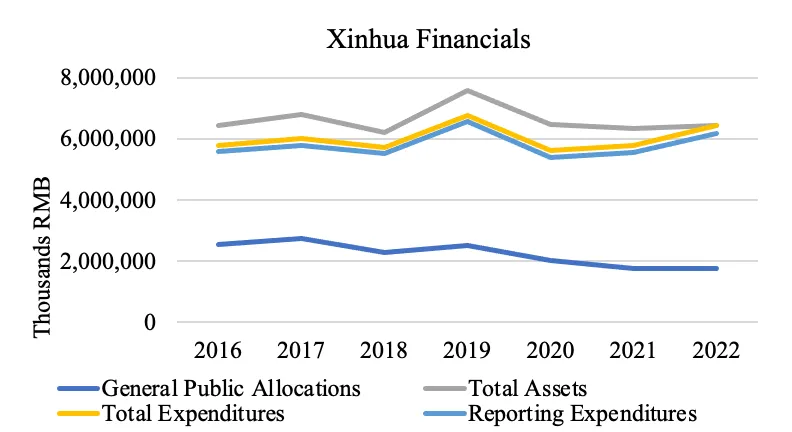
The aggregated financials of Xinhua show stable expenditures from 2016 to 2022 at around six billion RMB (USD $900 million). However, the amount of public funding it receives has decreased since 2017. The deficit was addressed by increasing revenues from the news business.
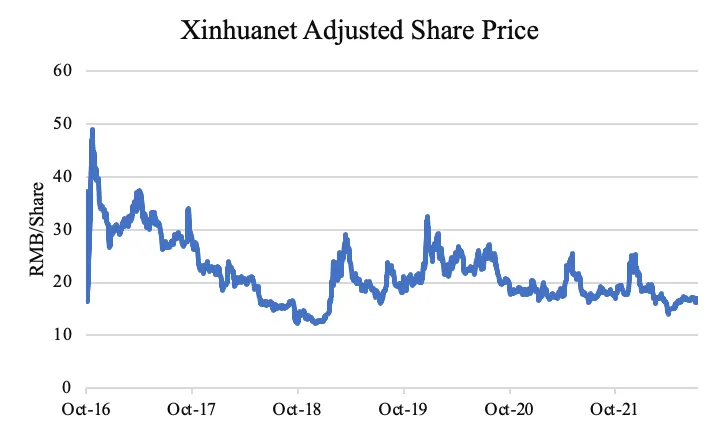
The publicly-traded online component of Xinhua known as Xinhuanet, which includes the outlets xinhuanet.com and news.cn, publishes annual reports to shareholders that offer insights into the company’s financial trajectory. Xinhuanet’s 2021 revenue reached new heights, exceeding 1.7 billion RMB (USD $250 million). This signals a recovery from the pandemic fueled loss in income the company had faced since 2019. However, when it comes to other financial metrics, Xinhuanet is on a downward trajectory. Its five main sources of revenue — online advertising, information services, mobile internet, network technical services, and digital content — have all lowered their profit margins when compared to 2016. Xinhua’s foreign operations income is minor when compared to domestic earnings. Among its foreign subsidiaries in Europe, Asia, and the US, only the US branch is profitable, with a net profit in 2021 of 1.1 million RMB ($152,000 USD). Xinhuanet’s reports cite the pandemic as the main cause of the stagnation that precipitously floored its profit margin and led to significant losses in 2021.
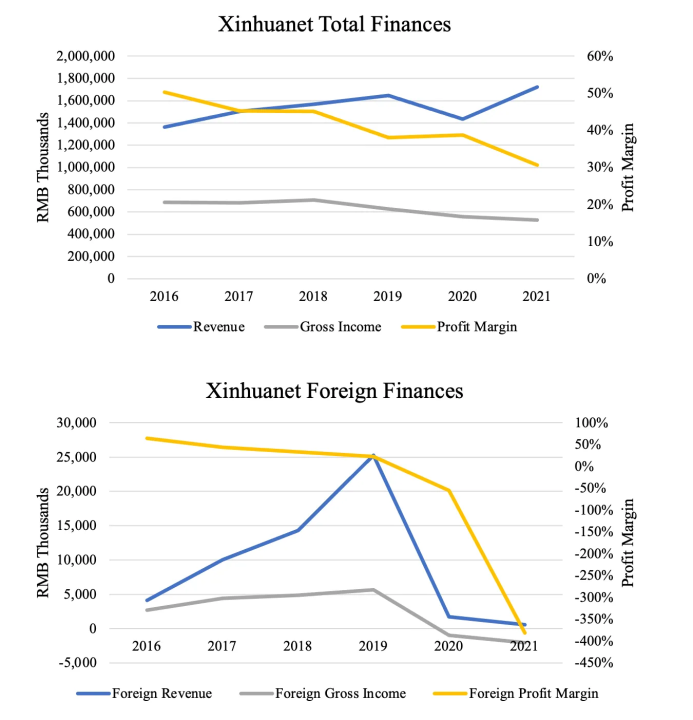
As one of the main arms of the central propaganda department, Xinhua has fully embraced “Xi Jinping Thought.” Xinhua outlined its information operations strategy in its 2021 annual report, in which it describes itself as “light cavalry” in the global “public opinion war.” The fourth component listed in its operational plan is “strengthening international broadcasting capacity.” The company also strives to improve its “public opinion fighting capabilities” in pursuit of becoming “the flagship of foreign propaganda.”
To achieve this, Xinhua has articulated a strategy for information operations that includes both “offensive and defensive” capabilities. In terms of defense, Xinhua has highlighted its use of new media and short video series, such as Xi Time (习近平时间) and China’s Choice (中国的选择), which spread Xi’s model of governance and tout China’s recent achievements.
Xinhua’s offensive information operations strategy relies on disinformation. As an example, Xinhua produced a series of series of documentaries under the umbrella “America’s Dark History Trilogy,” which aimed to smear US global leadership. “Fort Detrick Enigma” propagated the conspiracy theory that COVID-19 originated from an American weapons lab; “Virus Spreader” claimed the US intentionally spread the virus worldwide; and “Killing Machine” framed the US war in Afghanistan solely around war crimes. Describing the docuseries, Xinhua stated that it had “actively fought for international discourse power, and reports such as Fort Detrick Enigma, Virus Spreader, and Killing Machine, received nearly 500 million total views and sparked intense reactions overseas.”
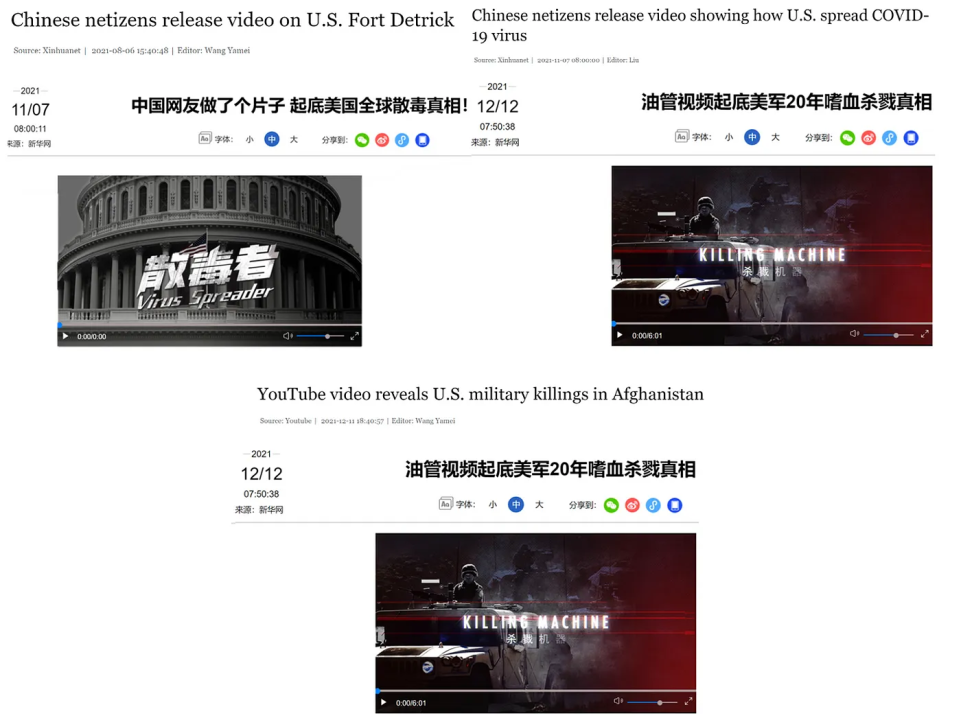
Xinhua may have timed the release of these videos to correspond with public events in an attempt to distract and discredit. Fort Detrick Enigma directed attention to the US facility at a time when the WHO requested additional audits of Wuhan laboratories in mid 2021. Virus Spreader blamed the US for spreading the virus when people in China were facing more stringent lockdown restrictions due to a new wave of the pandemic. And Killing Machine, which painted the US as lacking human rights judgement the Afghanistan war, was released a day after President Biden’s Summit for Democracy.
China Media Group
China Media Group (CMG) [中央广播电视总台] is the primary CCP news apparatus operating in video and radio. Amalgamated in 2018 from its subordinate departments, it is directed by the Central Propaganda Department with primary duties that include “disseminate the party’s theories, directives, and policies,” “provide internal reporting and sentiment information to the Party Central Committee and the State Council,” and “strengthen the construction of international broadcasting capabilities…tell the Chinese story well.” CMG is made up of four news divisions: China Central Television (CCTV), CGTN, China National Radio (CNR), and China Radio International (CRI). CGTN and CRI are the outward-facing arms of CCTV and CNR, respectively.
CMG’s party group has boasted of its international reach. In the CCP magazine Qiushi it said its content had been aired by numerous global media platforms, highlighting that Xi Jinping-related coverage had aired 12,000 times on 1,188 platforms in 88 different countries and regions. Furthermore, it claimed that CMG had become the sole source of news during tumultuous periods, compelling Western news outlets, like CNN and BBC, to quote it extensively. For example, the reports notes that following the withdrawal of American forces in Afghanistan, CGTN was one of the only news organization present for the Taliban’s first press conference.
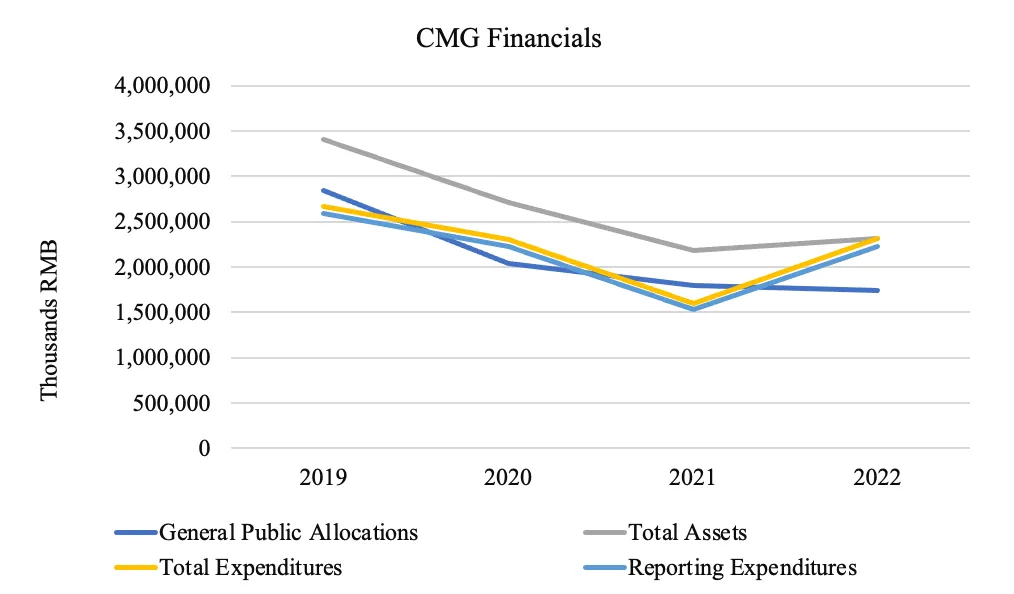
The aggregated financials of CMG show a marked decline in total assets available from 2019 to 2022. CMG was budgeted to receive 2.32 billion RMB (USD $344 million) in 2022, with 96 percent of its budget going towards “culture, tourism, sports and mass media,” and the rest going towards miscellaneous operating expenses, such as diplomatic outreach and housing. Given its custom of retaining about twenty percent of its total assets for the next year, CMG is projected spend about 1.9 billion RMB (USD $262,000) by the end of the 2022 fiscal year. This marks a small uptick since 2021. Overall funding has decreased since 2019, partly due to a pandemic-fueled drop in public funds, difficulties in foreign reporting, and directives from the State Council to cut spending.
Despite the budget cuts, CMG still financed media projects targeted at foreigners. In CMG’s 2021 financial statements, it detailed the promotional strategy for a historical romance drama it produced, The Rebel Princess (上阳赋), on YouTube and Google. Although the show did not expound communist ideologies, it was part of the plan to “tell the Chinese story well” and “promote the exportation of Chinese culture.” Its promotion emulated the South Korean model of cultural influence via the entertainment industry to cultivate soft power. Following an ad campaign in early 2021, the YouTube channel that hosted the show, China Zone, gained 370,000 subscribers and the show received millions of views.

CMG has also expanded funding for targeted and localized foreign propaganda projects. In 2022, CCTV worked on the Asian Cooperation Fund (亚洲合作资金项目), which received 2.03 million RMB (USD $280,00) to produce and broadcast 200 episodes of a Pashto-language television program in at least three major cities in Afghanistan, with the aim of “telling China’s story well.” The show would supplement existing programming on the Pashto branch of China Radio International (CRI Pashto). Similarly, in 2017, CGTN signed an agreement to broadcast a China-produced Pashto language news segment with Afghanistan’s Sharmshad TV, the largest Pashto-language TV station in the world, covering about 60 million Pashtuns in South Asia.
China’s programming in Pashto tends push the anti-Western themes seen in China’s broader propaganda narratives. For example, following the US pullout of Afghanistan in September 2021, CRI Pashto sought to undermine the notion of “democracy” and the global leadership of the US. In Facebook posts, it cited income inequality, racial discrimination, and poor pandemic response as critical flaws in US governance. It also drew on existing tensions within civil society to exacerbate local feelings of disappointment with the US withdrawal, using these to cast doubt on the concept of Western-led democracy and pointing to China’s model of governance as the viable alternative.
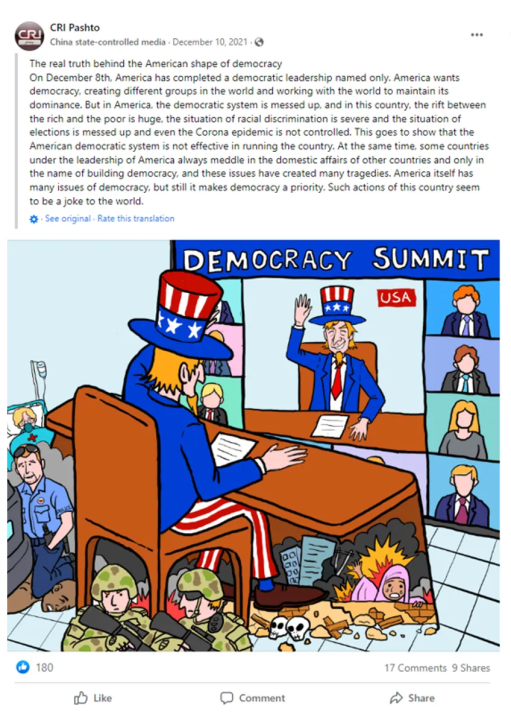
United Front Work Department and Beijing Propaganda Department
The United Front Work Department (UFWD) and the Beijing Propaganda Department’s finances are not publicly released. The latest publicly available metrics the DFRLab could find were from a 2015 report, which showed that the propaganda department received 2.5 billion RMB (USD $370 million) in 2015, a 433 percent increase from the year prior. The report explains that the increase is mainly due to an accounting policy change that transferred expenses to the public budget. Therefore, it is difficult to confirm whether the cash infusion was the result of a shift in priorities or policy.
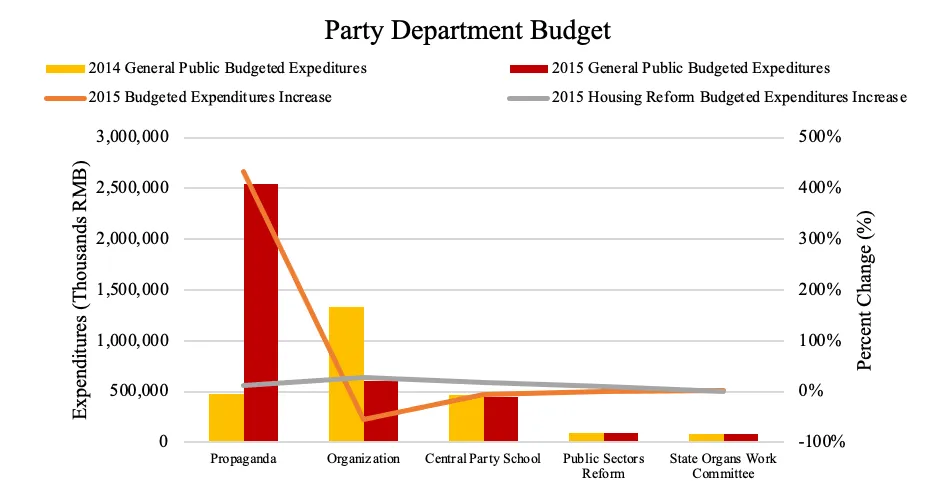
However, newly available data from the municipal Beijing branches of the UFWD and central propaganda department point to priorities within these organizations that can shed light on China’s broader goals. Both Beijing departments receive most of their funding from public funds, with the budget for the propaganda department being prioritized; it received nearly ten times more funding in 2022 than UFWD. However, the funding for the propaganda department is more volatile due to it largely being project-based. In 2022, the Beijing Propaganda Department’s investment in motion pictures, patriotic education, public notices, and arts promotion drove a higher allotment of resources compared to 2021.
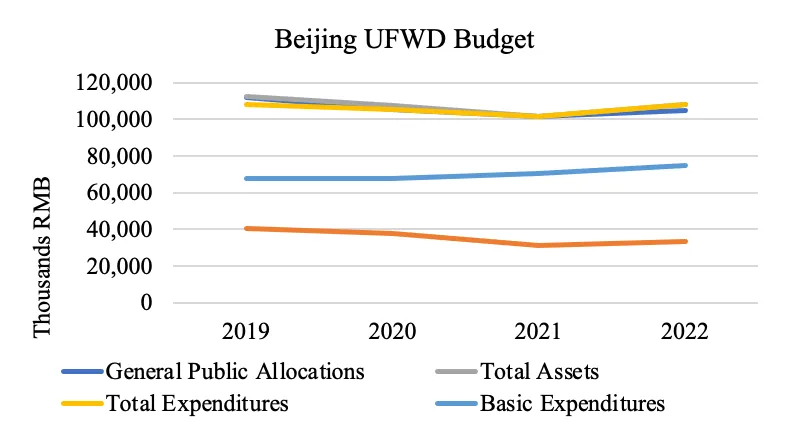
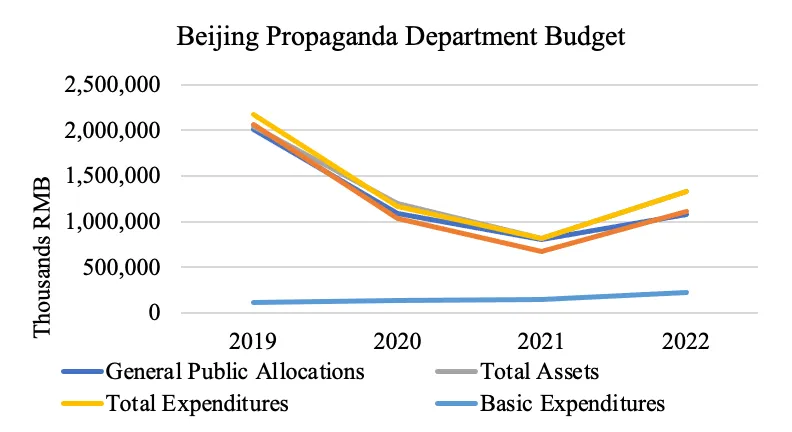
Beijing UFWD’s 2021 financial accounts detailed several of its overseas influence projects. One expenditure was titled “Western Returned Scholars Association (WRSA) Activities” and cost 1 million RMB (USD $138,000); its aim was to “fully leverage China’s study-abroad talent pool to serve the country.” The UFWD-affiliated WRSA has held joint events with Chinese Students and Scholars Associations (CSSAs) in the past, solidifying its overseas connections.
The department also emphasized innovation, for which it spent 500,000 RMB ($67,000 USD) on “new media.” To “reflect the cultural characteristics of the United Front” and “improve foreign influence and social attention,” the department experimented with a variety of multimedia formats. For example, it produced five short video interviews, a flash game, and six illustrations for themed party history event days, held in “red education bases.”
Since absorbing the Beijing Overseas Chinese Affairs Office (OCAC) in 2018, the UFWD has taken on more responsibilities. The Beijing branch spent 631,000 RMB (USD $87,000) for internal and external outreach programs. The external component targeted overseas Chinese groups, media, and schools to promote patriotic education and political events, such as the National People’s Congress and the Chinese People’s Political Consultative Conference, known together as the Two Sessions. The OCAC also funded an 873,000 RMB (USD $120,000) project to implement a permanent memorial in Beijing’s National Aquatics Center to advance “the spirit of patriotism” in the overseas Chinese community and create a base of “patriotic education.” The exhibition also sought to promote “the 2022 Beijing Winter Olympics and eliminate the influence of Western countries’ boycott of the Winter Olympics.”
With a much larger budget, the Beijing Propaganda Department sought to disseminate its messages through grander productions. The project with the largest budget was awarded 90 million RMB (USD $12.3 million) to develop the movie industry in Beijing in 2022. A separate 912,000 RMB (USD $125,000) is to be spent on advertising Beijing movies to a foreign audience at venues such as film festivals. Last year, Xinhua praised the Beijing film industry for having “thoroughly studied and implemented Xi Jinping’s new era of socialism with Chinese characteristics,” and for celebrating movies with “central themes,” such as the top grossing film “The Battle at Lake Changjin,” which depicts Chinese soldiers fighting United Nations forces during the Korean war. It profited from the demand for patriotic films and made 5.77 billion RMB (USD $794 million), the highest-grossing film in Chinese history.

The propaganda department also funded exhibitions at home and abroad. “Experience China”(“感知中国”) and “Charming Beijing” (“魅力北京”) are two long-running exhibitions that have been shown in many countries. In addition, a five-day cross-cultural exchange event for Belt and Road Initiative (BRI) countries received 1.3 million RMB (USD $179,000). Further innovating, the department also has plans to run a video game exhibition, also priced at 1.3 million RMB (USD $179,000), targeting overseas consumers that is expected to reach 10 million people.
Establishing partnerships in journalism is another focal area. A seven million RMB project establishes a partnership with foreign journalists in Beijing to “tell the world a comprehensive, real and three-dimensional Beijing.” The propaganda department is also co-producing a 104-episode documentary series, also titled “Charming Beijing,” and promoting it abroad with BRI partner countries in two listed project items, totaling 5.9 million RMB (USD $875,000). The propaganda department expects the series to reach eight million viewers on two major foreign TV networks.
Through the financial statements of these four organizations, the DFRLab found considerable funding for foreign influence projects across a range of avenues. Direct Chinese disinformation projects, like the “America’s Dark History Trilogy,” aim to spread anti-Western narratives. Simultaneously, soft power TV shows and exhibitions showcase a lovable China as a place to visit and invest in. Spending on these projects is expected to increase in the following years as China develops its economy and continues to seek greater international status.
Cite this case study:
“How China funds foreign influence campaigns,” Digital Forensic Research Lab (DFRLab), January 12, 2023, https://medium.com/dfrlab/how-china-funds-foreign-influence-campaigns-72d547ad0771.

